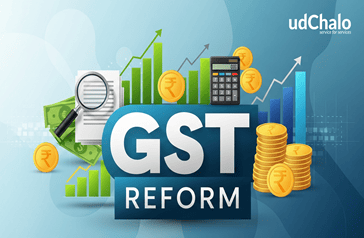How is Income Tax Rebate Under Section 87A Calculated?
In this article
Filing income tax can often feel overwhelming when rebates and exemptions are involved. One such important provision is the Section 87A rebate, which can help you lower or even eliminate your tax liability.
This article explains how the rebate is calculated, who is eligible to claim it, and what to keep in mind when filing your ITR. Whether you are a civilian or a member of the defence community, the guide will simplify the process.
What is Section 87A Rebate
Before learning the calculation, it is important to understand what the rebate means. Section 87A is a relief that reduces the income tax you pay if your taxable income is below a certain level.
It does not reduce your income but only lowers the final tax payable. The rebate is applied before the health and education cess is added.
Quick Reference: Section 87A Rebate
The rules for the rebate are different in the old and new regimes. Here is a quick reference for easy understanding.
Old Tax Regime (FY 2025-26)
- Eligibility: Resident individuals with taxable income up to ₹5 lakh.
- Rebate Amount: Up to ₹12,500 or actual tax liability, whichever is lower.
- Purpose: Brings tax liability down to zero if your tax before rebate is ₹12,500 or less.
New Tax Regime (FY 2025-26 / AY 2026-27)
- Eligibility: Resident individuals with taxable income up to ₹12 lakh (₹12.75 lakh for salaried after standard deduction of ₹75,000).
- Rebate Amount: Up to ₹60,000 or actual tax liability, whichever is lower.
- Marginal Relief: Ensures that extra tax does not exceed extra income if you cross ₹12 lakh.
Note: Rebate applies to tax liability before adding the 4 percent health and education cess.
Read More: 9 Key Changes in ITR-1 to ITR-4 for FY 2024-25 (AY 2025-26)
Section 87A Rebate Limits (Old vs New Tax Regime)
The rebate rules are not the same in the old and new tax regimes. Each regime has different income limits and maximum rebate amounts.
The table below explains the difference between the two regimes clearly.
| Particulars | Old Tax Regime (FY 2025-26) | New Tax Regime (FY 2025-26) |
|---|---|---|
| Eligible Taxable Income | Up to ₹5,00,000 | Up to ₹12,00,000 (₹12.75 lakh for salaried with standard deduction) |
| Maximum Rebate Allowed | ₹12,500 | ₹60,000 |
| Who Can Claim | Resident individuals | Resident individuals |
| Exclusions | Non-residents, HUFs, firms, companies | Same as old regime |
| Effective Tax Payable | Zero if conditions met | Zero if conditions met |
Read More:Understanding the New Tax Regime vs. Old Tax Regime for FY 2024-25
How is Section 87A Rebate Calculated
The calculation of Section 87A follows a simple process. It starts with finding your taxable income and ends with applying the rebate.
Here is a step-by-step breakdown.
- Compute your gross income from salary, pension, business, or profession.
- Claim deductions under 80C, 80D and others if you are in the old regime.
- Subtract deductions from gross income to arrive at taxable income.
- Apply the income tax slab rates as per your chosen regime.
- If your taxable income is within the limit, reduce your tax liability by the rebate amount.
Example Calculations
Examples help you see how the rebate works in real situations. Depending on your income and chosen regime, the rebate can bring your tax down to zero.
The table below shows sample cases.
| Case | Taxable Income | Regime | Tax Before Rebate | Rebate | Final Tax |
|---|---|---|---|---|---|
| A | ₹4.95 lakh | Old | ₹12,250 | ₹12,250 | ₹0 |
| B | ₹12 lakh (salaried) | New | ~₹58,500 | ₹58,500 | ₹0 |
| C | ₹12.25 lakh | New | ~₹62,000 | Marginal Relief | ~₹500 |
| D | ₹12 lakh including ₹75,000 STCG | New | Tax on salary plus STCG | Rebate covers salary part only | Manual claim required for STCG |
Budget 2025 Updates on Section 87A
The Union Budget 2025 introduced key changes that expanded the benefit of Section 87A under the new tax regime. The rebate limit was raised to ₹12 lakh and ₹60,000, providing greater relief for middle-income taxpayers.
For salaried employees, the standard deduction of ₹75,000 further extends effective eligibility to ₹12.75 lakh. These updates make the new regime more attractive for a wider group of taxpayers.
Jargon Buster
Tax terms often create confusion. Here are some common jargons explained in simple words.
- Tax Liability: The total tax you owe before adding cess.
- Rebate: A reduction in tax payable, not in your income.
- Marginal Relief: A safeguard to ensure you do not pay more tax than the extra income earned above the limit.
Dos and Don’ts for Section 87A Rebate
Many people miss out on the rebate due to common mistakes. Following some dos and don’ts ensures you claim it correctly.
Here are some simple rules to remember.
Dos
- Check your income carefully before selecting a tax regime.
- File your ITR before the deadline to claim the rebate.
- Apply the rebate manually if you have capital gains income.
Don’ts
- Do not assume non-residents can claim a rebate. Only resident individuals are eligible.
- Do not forget that the rebate is applied before cess.
- Do not confuse the income limits of old and new regimes.
Tips for Defence Personnel
Serving and retired defence personnel often receive allowances and pensions. Some are taxable while others are exempt, which can affect your rebate eligibility.
If your taxable income after exemptions is within the rebate limit, you can save tax completely.
To simplify the process, you can use udChalo’s tax filing services. You may also choose CA-assisted ITR filing at the lowest guaranteed price at just ₹499/- only.
Why Section 87A Matters?
The Section 87A rebate is one of the simplest ways to save tax if your income is within the limit. Knowing how it works ensures you never pay more than required.
If you are unsure about calculations or exemptions, using services like udChalo’s Tax Filing Assistance can help you claim your rebate without mistakes.
Related Articles

The Next-Gen GST Reform 2025 brings significant tax relief across essentials, healthcare, farming, education, automobiles, and electronics. Here’s a complete breakdown of what’s cheaper and how it supports soldiers, veterans, and families.

This Navratri and Diwali, India celebrates with savings thanks to the Next-Gen GST Reform 2025. Electronics, cars, and real estate are now more affordable, benefiting both civilian and defence families.

Timely filing of your return isn’t just about avoiding penalties. It can also help you earn more through interest on your tax refund. Here’s why the 15 September 2025 deadline is critical for boosting your refund.
Frequent Asked Questions
Related Post

The Next-Gen GST Reform 2025 brings significant tax relief across essentials, healthcare, farming, education, automobiles, and electronics. Here’s a complete breakdown of what’s cheaper and how it supports soldiers, veterans, and families.

This Navratri and Diwali, India celebrates with savings thanks to the Next-Gen GST Reform 2025. Electronics, cars, and real estate are now more affordable, benefiting both civilian and defence families.

Timely filing of your return isn’t just about avoiding penalties. It can also help you earn more through interest on your tax refund. Here’s why the 15 September 2025 deadline is critical for boosting your refund.








